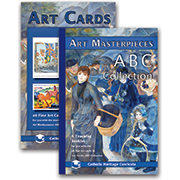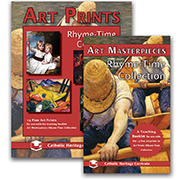Catholic Heritage Curricula makes use of beautiful art prints as the centerpieces of lessons for Catholic homeschoolers in six Art Masterpieces courses. The courses and their suggested age/grade levels are:
Art Masterpieces: ABC Collection - ages four through six
Art Masterpieces: Rhyme-Time Collection - kindergarten
Art Masterpieces: Childhood Collection - first grade
Art Masterpieces: Nature Collection - for second grade
Art Masterpieces: Adventure Collection - third grade
Art Masterpieces: Liturgical Collection - fourth grade
 Art Masterpieces: ABC Collection consists of a collection of 26 half-page size art cards plus a 58-page teaching booklet. Each of the art cards features a painting that connects to a letter of the alphabet. The painting “Muddy Alligators” represents the letter “a.” The painting “The King Watches” features a lion to represent the letter “l.” “The Martyrdom of St. Andrew” shows St. Andrew tied to poles in the form of an “x” to illustrate that letter. Parents challenge children to match cards with the letters of the alphabet.
Art Masterpieces: ABC Collection consists of a collection of 26 half-page size art cards plus a 58-page teaching booklet. Each of the art cards features a painting that connects to a letter of the alphabet. The painting “Muddy Alligators” represents the letter “a.” The painting “The King Watches” features a lion to represent the letter “l.” “The Martyrdom of St. Andrew” shows St. Andrew tied to poles in the form of an “x” to illustrate that letter. Parents challenge children to match cards with the letters of the alphabet.
In addition, when each card is first presented the parent can share brief information about the artist from the teaching booklet then lead a discussion using information and questions from the booklet. Questions are designed to teach children to observe details, especially colors, shapes, and numbers of items. Some questions have children compare two art cards while looking at a particular detail. Parents can use as many activities as they wish for each child.
 Art Masterpieces: Rhyme-Time Collection has a set of 15 full-page prints plus a 65-page booklet that serves as both a teaching tool and activity book. Additional sheets in the packet of art prints have small images of the same 15 artworks plus others by the same artists—four images per page—that are to be cut out and pasted into the booklet.
Art Masterpieces: Rhyme-Time Collection has a set of 15 full-page prints plus a 65-page booklet that serves as both a teaching tool and activity book. Additional sheets in the packet of art prints have small images of the same 15 artworks plus others by the same artists—four images per page—that are to be cut out and pasted into the booklet.
A new art masterpiece is introduced every two weeks, with four sessions in each two-week period. Nursery rhymes are taught in conjunction with the art.
For example, during the first session for the painting, “The Potato Harvest,” you show the art print to the child; read the nursery rhyme “One potato, two potato,….”; read brief information about the artist; and discuss the artwork using information and questions under “Art Story.” Children also begin memorizing the nursery rhyme.
The second session teaches very basic art theory. For example, on page 16 it says, “Use your finger to trace over the line that marks where the sea meets the sky. This is called the horizon. Trace the line that marks where the sea meets the land. The artist made the lines smooth and straight to make the painting seem calm and peaceful.”
In the third session, you will use “Discussion Ideas” plus “Extension Activities” if they are included. Occasionally the activities include some sort of artwork.
In the fourth session, students will identify the artwork they have been studying from the sheet of four smaller images. They can cut out then paste that artwork image into the booklet. Then on sheets 5 through 8 in the packet, they will search for a similar painting by the same artist to also cut out and paste into the booklet. Children should be able to recite the nursery rhyme in this session as well. Small, decorated cards with the nursery rhymes (included in the packet with the art prints) can also be cut out and pasted into the booklet.
The other four courses are structured like the Rhyme-Time Collection but with poems to be memorized and gradually increasing levels of difficulty. Most courses can be used a year earlier or later, which allows larger families to have two or three children working on the same level.
Summary
The beautiful images in these courses should be kept on display while you are studying each artwork. Lessons are intended to help children enjoy art, so you can adapt lessons to suit your situation. All of these courses help parents introduce the beauty of art to children with minimal planning and effort.







